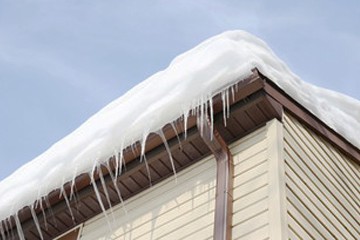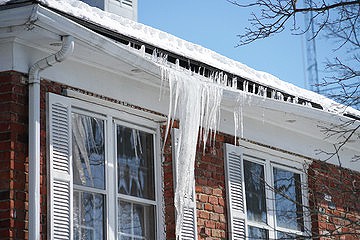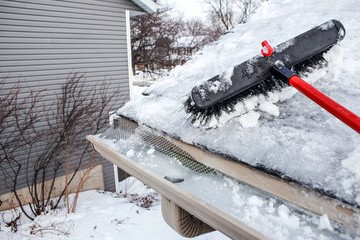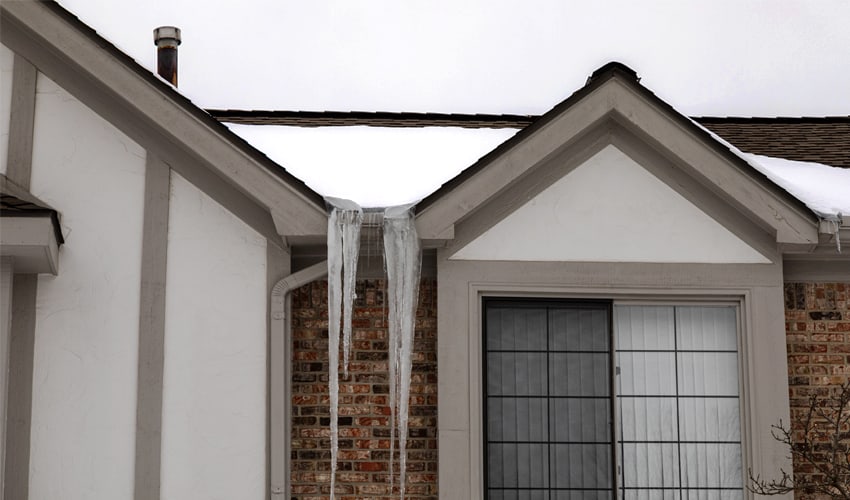With winter months expected to bring freezing temps, and intermittent rain and (potential) ice/snow showers, homeowners should be on the lookout for ice dams. Ice dams form when the snow on your roof melts and flows downward, then refreezes at the edge of your roof. This can cause significant damage to your roof and even cause water to back up into your home. Fortunately, there are steps you can take to prevent ice dams from forming. By following these tips, you can protect your roof and your home from the hazards of ice dams. Stay safe this winter season and keep your roof in top shape.
What is an Ice Dam?
First, lets get up to speed on ice dams and why you need to know about them. Ice dams are a common problem for homeowners in areas with cold climates. An ice dam is an accumulation of snow and ice on a sloped roof, which typically forms when melting snow refreezes near the edge of the roof. If left unchecked, ice dams can cause water to back up under the shingles and leak into the home.
What Causes Ice Dams?
The most common cause of ice dams is a combination of improper attic insulation, poor attic ventilation, clogged gutters, and warm air from the home entering the attic.
During cold weather, snow accumulates on the roof, and if the warm air from the home reaches the roof, it can cause the snow to melt. If the meltwater is not able to drain off the roof, it will refreeze on the edge of the roof, creating an ice dam. Uncontrolled snow melt, excessive snow accumulation, and clogged or damaged roof vents can also contribute to ice dam formation.
Effects of Ice Dams
Ice dams can be a serious problem for homeowners. They can cause water to backup and leak into the home, leading to water damage, mold growth, and other structural damage. They can also damage the roof itself, with cracked shingles and holes forming. Gutters, downspouts, and other roofing components can become blocked, leading to water overflow and erosion.
Ice dams can also increase energy costs by trapping heat in the attic and preventing it from escaping through the roof. This can lead to higher energy bills for the homeowner.
Finally, ice dams can be hazardous when they melt and refreeze, creating a slippery walking surface that can lead to slips, trips, and falls. It is important to take action to remove ice dams quickly to prevent further damage and injury.
Ice Dam Prevention
Ice dams can be a serious problem for homeowners, but with proper long-term and short-term control, it is possible to minimize the risk of ice dam damage. Long-term ice dam control involves the installation of proper insulation and ventilation, which allows for proper airflow within the attic and prevents excess heat from melting snow and ice on the roof. Additionally, the use of heated cables along the eaves and valleys of the roof can help reduce the amount of melting snow and ice that accumulates on the roof.
To ensure proper long-term ice dam control, it is important to regularly inspect the roof for signs of ice and snow accumulation. Short-term ice dam control can be achieved through the use of ice melting products such as calcium chloride and sodium chloride that are applied directly to the affected area. Proper maintenance of the roof and gutters is also important in preventing ice dams from forming. It is important to ensure that gutters and downspouts are clear of debris, and that the roof is free of any ice or snow accumulations. By following these tips, homeowners can take proactive steps to reduce their risk of ice dam damage.
Sample Ice Dam Action Plan
Here is an example of a game plan to prevent ice dams from becoming a problem for your home. First, it is important to regularly remove snow from the roof with a snow rake. This will help prevent the accumulation of snow which can lead to ice dams.
In addition to removing snow, homeowners should also install a drip edge at the edge of the roof to help direct the water off the roof and away from the house. You should also make sure your roof is in good condition, without any cracks or gaps in the shingles. Homeowners should seal any cracks or holes in the roof with a high-quality sealant.
As previously mentioned, insulating the attic can also help reduce heat loss and prevent warm air from melting the snow. It is also important to make sure the attic and roof have adequate ventilation to prevent moisture buildup. Installing a membrane or ice and water shield on the roof can also help prevent water from seeping through.
Finally, homeowners should inspect their roof regularly for signs of ice dams and potential water damage, and repair any existing damage caused by ice dams. Additionally, you should clear your gutters of debris and leaves to ensure proper drainage of melting snow and ice away from your foundation. Taking these steps can protect your home and love ones from more drastic issues.
Mechanical Attic Ventilation is Not Recommended
Mechanical attic ventilation systems, while popular among homeowners, are not a viable solution for preventing ice dams from forming on your roof. Attic ventilation systems do not remove heat from the attic, which is a major factor in the formation of roof ice dams. Additionally, these systems can create airflow problems, allowing warm air to escape from the attic and into the roof, further contributing to the formation of ice dams.
Not only are mechanical attic ventilation systems expensive to install, maintain, and operate, but they do not guarantee that ice dams will not form, and can often be ineffective. These systems can also create moisture problems in the attic, which can lead to mold and mildew growth. Therefore, homeowners should be aware that mechanical attic ventilation systems are not a viable solution to the problem of roof ice dams. Always consult with a professional roofer to answer any questions you have about protecting your home from ice dams or any other common concerns.
How to Get Rid of Ice Dams (De-icing Methods)
Ice dams on roofs can be a major problem during the winter months. Fortunately, there are several methods available to help remove these troublesome obstacles. These methods range from heating cables to chemical melting agents, hot water, roof rakes, and even heat guns.
- Heating cables are one of the most commonly used de-icing methods for roof ice dams. These cables are typically made of metal and contain a heating element that can be manually adjusted depending on the temperature. This method is especially useful for large ice dams, as the cables can be adjusted to provide a constant source of heat to melt the ice.
- Chemical melting agents are also an effective way to remove ice dams from roofs. These agents are usually applied to the roof with a sprayer and then left to dissolve the ice. This method is usually used in combination with other de-icing methods, such as heating cables, as it can help to speed up the melting process.
- Hot water is another popular de-icing method for roof ice dams. This method is typically used in combination with a sprayer, as the hot water is sprayed onto the roof and then allowed to melt the ice. This method is especially useful for smaller ice dams, as it does not require the use of heating cables or chemical melting agents.
- Heat guns use an electric current to generate heat, which is then used to melt the ice on the roof.
In Doubt? Call in the Pros
Again, with winter weather fast approaching, it is essential to remember these tips to protect your roof and home from ice dams. Make sure you and your house are safe this winter, and keep your roof in great condition. If you don't feel that you have the skills to do the work yourself, or if you just want a professional opinion, call us. We can send a roofer to evaluate your home's potential for prevention and/or ice dam removal.






